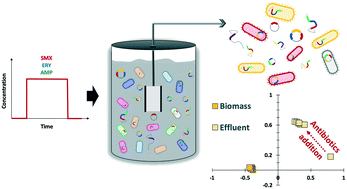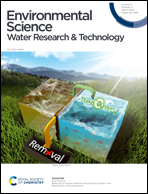Microbial community and antibiotic resistance profiles of biomass and effluent are distinctly affected by antibiotic addition to an anaerobic membrane bioreactor†
Abstract
The transfer of antibiotic resistance to pathogenic bacteria is one of the most eminent human health threats and a concern in water reuse schemes. Anaerobic membrane bioreactors (AnMBRs) are an emerging wastewater treatment biotechnology with significant potential for mainstream wastewater treatment. However, AnMBR effluents remain largely unexplored with respect to their microbial community composition and their antibiotic resistance profiles. In this study, we operated a bench-scale AnMBR for the treatment of domestic wastewater containing antibiotics (250 μg L−1 each of sulfamethoxazole, ampicillin, and erythromycin) and evaluated microbial community structure and antibiotic resistance gene (ARG) dynamics in both the biomass and effluent. Results showed that ARG abundances in the biomass of the AnMBR consistently increased throughout the experiment, while the effluent ARG abundances saw a sharp increase upon initial antibiotic exposure to the system and then dropped immediately thereafter. Further, a vastly more variable microbial community was observed in the AnMBR effluent as compared to the biomass. Several potentially pathogenic genera in the effluent were strongly correlated with the abundance of specific resistance genes (e.g., sul1), as well as a class 1 integrase gene (intI1). Overall, the results of this study provide useful insights into the association of ARGs with microbial community dynamics in AnMBR, which is needed to devise operational and design strategies to lessen dissemination of antibiotic resistance to the environment.



 Please wait while we load your content...
Please wait while we load your content...